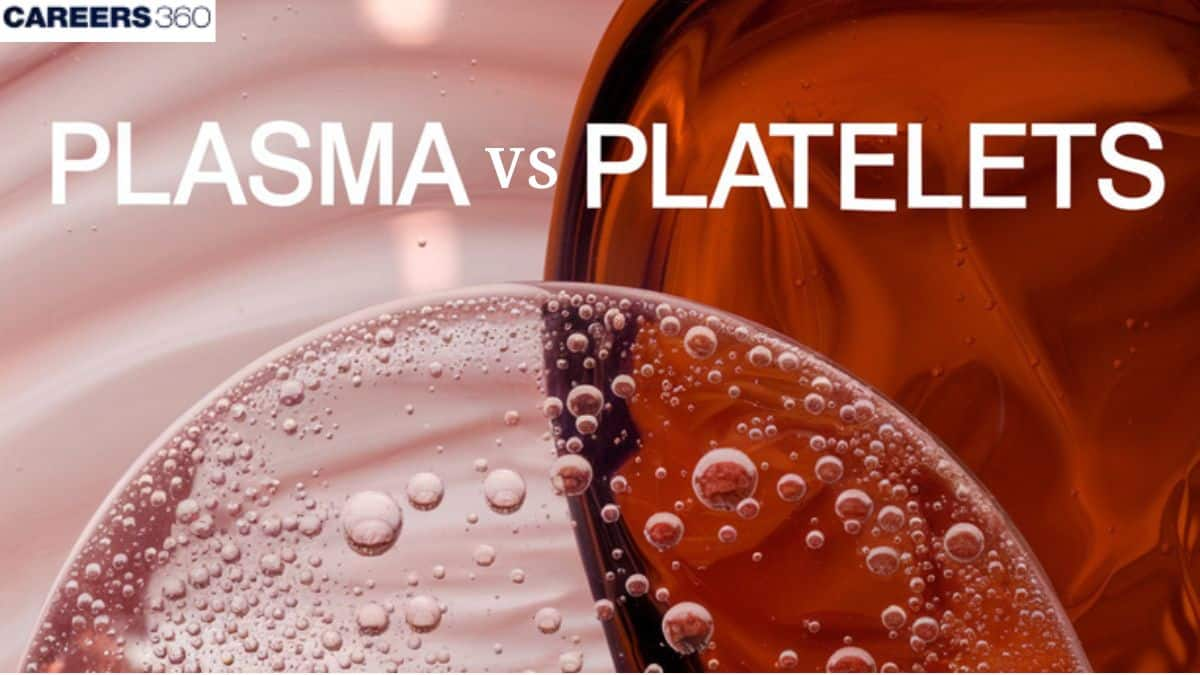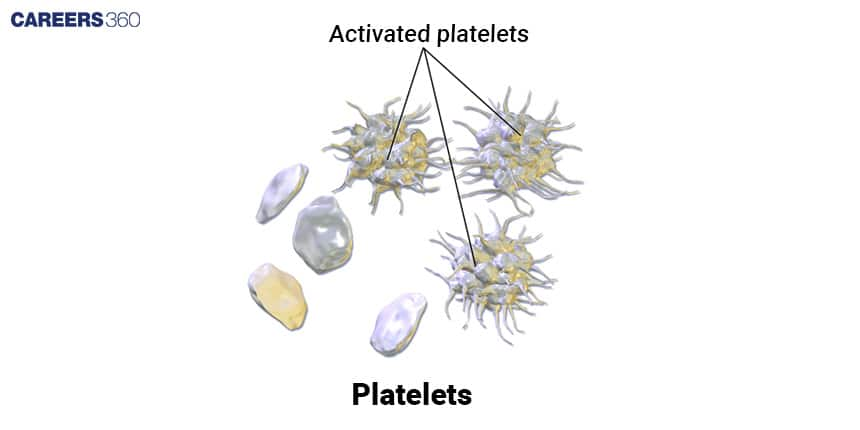Difference Between Plasma And Platelets
Plasma and platelets are two vital components of blood with distinct roles. Plasma is the liquid medium that transports nutrients, hormones, and wastes, while platelets are cell fragments crucial for clotting and wound healing. Understanding their differences is essential for NEET and Class 11 Biology.
This Story also Contains
- What is Plasma in Blood?
- What are Platelets?
- Key Differences Between Plasma And Platelets
- Role of Plasma and Platelets In Health
- Plasma vs Platelets NEET MCQs (With Answers & Explanations)

What is Plasma in Blood?
Plasma is the fluid portion of the blood and makes up approximately 55% of the total volume. This pale yellow fluid is the medium in which many substances are transported throughout the body.
Composition of Plasma
Water: Plasma is primarily composed of water, about 90-92%, that acts as the solvent for various solutes.
Proteins: Plasma contains albumin, involved in the maintenance of osmotic pressure, globulins, involved in immune responses, and fibrinogen, which is necessary for blood clotting.
Electrolytes: Plasma contains important electrolytes such as sodium, potassium, calcium, and bicarbonate, the major factors in the maintenance of fluid balance and nerve conductance.
Nutrients: Plasma carries nutrients, mainly glucose, amino acids, and lipids, to cells for energy and growth.
Waste Products: Plasma carries metabolic waste products, for example, urea and creatinine, to the kidneys for excretion.
Functions of Plasma
Transport: Plasma serves as a medium of transport for nutrients, hormones, gases, and waste products, enabling their circulation across the body.
Regulation: Plasma participates in the regulation of body temperature, pH levels, and osmotic pressure and thus contributes to the preservation of homeostasis.
Immune function: Plasma proteins including antibodies are involved in the immune response to protect the host from infection.
What are Platelets?
Platelets are small, disc-shaped fragments of cells that are involved in blood coagulation and hemostasis. They are important in preventing loss of blood when the vessels are injured.
Composition of Platelets
Cell Fragments: Platelets are fragments of cells, and not cells themselves. The megakaryocytes are gigantic cells that reside in the bone marrow.
Granules: Platelets possess granules that pack different products of these cells, for example, clotting factors and growth factors, which are crucial for their functioning.

Functions of Platelets
Hemostasis: The most important function of platelets is to prevent haemorrhage by acting as a plug that forms at the site of injury in the vasculature.
Blood Clotting: Chemicals released by platelets promote the cascade of coagulation, ultimately leading to a stable blood clot.
Wound Healing: Growth factors released from platelets are responsible for tissue repair and regeneration following injury.
Key Differences Between Plasma And Platelets
Feature | Plasma | Platelets |
Definition | Plasma is a straw-colored liquid portion of blood, consisting mostly of water and proteins | Platelets are small, colorless, disk-shaped cell fragments found in blood |
Function | Transports nutrients, hormones, and waste | Involved in clotting and wound healing |
Type | A liquid that holds blood cells | A type of blood cell |
Volume | Makes up about 55% of blood volume | Comprises a negligible fraction of blood volume |
Role of Plasma and Platelets In Health
Both plasma and platelets are integral parts of the maintenance of health.
Nutrient and waste products are transported by plasma helps in cellular functioning
While platelets prevent excessive bleeding and facilitate clotting to start the healing process of wounds.
Disorders of either component lead to serious health complications.
Plasma vs Platelets NEET MCQs (With Answers & Explanations)
Important topics for NEET exam are:
Components of Plasma
Components of Platelets
Major differences
Disorders related to plasma and blood
Practice Questions for NEET
Q1. The life span of thrombocytes is
3 to 4 weeks
4 to 5 weeks.
3 to 7 days
None of the above
Correct answer: 3) 3 to 7 Days
Explanation:
They are non-nucleated round, biconvex cells. They originate from megakaryocytes by cytoplasmic extension. They release clotting factor (thromboplastin) for blood coagulation at the site of injury. Platelets play a crucial role in wound healing by forming a platelet plug, which helps seal blood vessels and stop bleeding. They also release other substances that help in the constriction of blood vessels and the promotion of tissue repair. Platelet count and activity are essential for maintaining proper clotting and preventing excessive bleeding.
Hence, the correct answer is option 3) 3 to 7 days.
Q2. How serum is different from plasma in having
Excess of fibrinogen and other clotting factors
Absence of fibrinogen and other clotting factors
Absence of haemoglobin
Excess of haemoglobin
Correct answer: 2) Absence of fibrinogen and other clotting factors
Explanation:
The serum is similar to plasma in terms of its composition, but it does not contain clotting factors or fibrinogen, which are removed during the process of blood clotting. Serum contains a variety of important proteins, electrolytes, hormones, enzymes, and other substances that are important for various physiological functions in the body.
Plasma constitutes 55% of the total blood present in the human body.
The explanation for the Incorrect option:
Haemoglobin is a protein found in red blood cells that binds with oxygen to transport it from the lungs to the body's tissues. It is essential for oxygen delivery to cells and tissues throughout the body.
Hence, the correct answer is option 2) Absence of fibrinogen and other clotting factors.
Q3. A decrease in platelets count is termed as
Leucocytopenia
Thrombocytopenia
Leukemia
Thrombocytic
Correct answer: 2) Thromobocytopenia
Explanation:
Thrombocytopenia is a condition where there's a decrease in the platelet count. This can lead to what are known as bleeding disorders like purpura. The normal life of a platelet is typically 5 to 9 days. When platelet count goes below 150,000 per microliter of blood, individuals might experience increased bruising and prolonged bleeding due to the impaired ability of blood to clot, which requires medical evaluation and possible treatment.
Hence, the correct answer is Option 2) Thrombocytopenia.
Also Read:
Frequently Asked Questions (FAQs)
Plasma is the liquid portion of blood that carries nutrients, hormones, gases, and waste products throughout the body.
Small cell fragments are involved in blood clotting to prevent excessive bleeding.
Plasma acts as a transport medium for various materials in the body.
Platelets physically fill in the site of damage by forming a soft plug and also release chemicals that stimulate the coagulation sequence.
Plasma is the liquid component of the blood; platelets are pieces of cells. Plasma transports, while platelets clot.